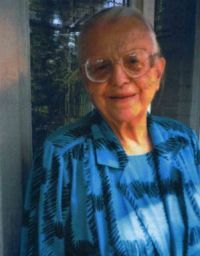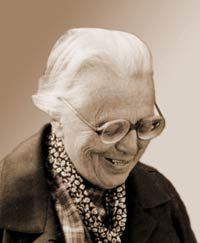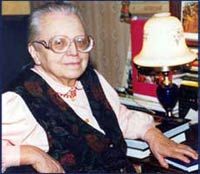(b. September 9, 1919, in Simbirsk Governorate, Russia – d. February 21, 2000, in Kyiv).
Historian, researcher of the history of Ukraine during the Cossack era and of Cossack chronicles, specialist in the fields of historiography, source studies, archaeography, bibliography, manuscript studies, marginalia studies, historiosopher, journalist, educator, and laureate of the Taras Shevchenko National Prize of Ukraine.
Her father was a railroad worker of Belarusian descent, and her mother was of Polish noble lineage. Olena was the fifth of ten children, most of whom died in childhood. She was born in a train car. The family moved frequently: Belgorod, Sumy, Kharkiv, Harbin (Manchuria), and then Kharkiv again. She witnessed horrific scenes of famine: dead peasants on the streets of Kharkiv. Her father left the family, and her mother died in 1935. In 1936, A. graduated from secondary school with honors (her character reference described her as “outstanding in her abilities”). From 1937 to 1938, she studied at the Communist Institute of Journalism under the Central Committee of the All-Union Communist Party (Bolsheviks) in Moscow. Its instructors were repressed, and the institute was liquidated. A. was transferred to the Kharkiv Pedagogical Institute, from which she graduated in 1941 with a degree in Russian language and literature. During the war, she was evacuated to Kazakhstan and Bashkiria, where she worked for the State People’s Commissariat of Health and later for the Bashkir Radio Committee. She lived on the verge of starvation.
In 1944, A. returned to Kharkiv, but since their home had been destroyed, she moved to Kyiv in May. She worked as a researcher, a senior researcher, and head of the ancient acts department at the Central State Historical Archive of the Ukrainian SSR, where, in her words, she “simply fell in love with the Ukrainian Cossacks.” From 1945 to 1948, she was a postgraduate student under the historian Kost Huslysty, and in 1948 she defended her candidate’s dissertation, “The Zaporozhian Host, Its Structure and Combat Operations as Part of the Russian Army during the Russo-Turkish War of 1768–1774.” She processed a vast number of archival materials from the 16th to the 18th centuries.
From 1950 to 1972, she worked at the Institute of History of Ukraine in Kyiv. In 1961, A.’s monograph *The Zaporozhian Sich in the Struggle Against Turko-Tatar Aggression: The 1650s–1670s* was published.
When the Ukrainian Society for the Protection of Historical and Cultural Monuments was established in 1966, A. joined its Board and worked with great enthusiasm. She wrote about 80 articles for the *Ukrainian Soviet Encyclopedia* (URE), the *Ukrainian Soviet Encyclopedic Dictionary* (URES), the *Soviet Encyclopedia of the History of Ukraine*, and the *Soviet Historical Encyclopedia*. Before the flooding of four Sich territories by the waters of the Kakhovka Hydroelectric Power Plant, she worked there in an archaeological expedition. In connection with the 1965 declaration of Khortytsia Island as a State Historical and Cultural Reserve, A. compiled a list of memorable sites of the Zaporozhian Cossacks, which was published in the journal *Ukraina* in 1967–68. She participated in academic conferences, and her brilliant public lectures on Cossack history gained great popularity. But when A. presented a plan for a series of lectures and other educational events to the Vice President of the Academy of Sciences of the Ukrainian SSR, I. Bilodid, he said: “Why, that’s just fodder for nationalists!” Meanwhile, A. associated with Olena Kompan, Mykhailo Braichevsky, Yaroslav Dzyra, Viktor Ivanysenko, Borys ANTONENKO-DAVYDOVYCH, Hryhoriy KOCHUR, Nadiya SUROVTSOVA, Ivan DZIUBA, and Mykhailyna KOTSIUBYNSKA, read samizdat literature, and listened to foreign radio stations.
At the end of 1969, with the support of P. Yu. Shelest, A.’s monograph *The Armed Forces of Ukraine in the First Half of the 18th Century* was published. However, after his removal from the post of First Secretary of the Central Committee of the Communist Party of Ukraine, the 1972 arrests of the intelligentsia, and the subsequent ideological pogrom, the Cossack theme became an “ideological crime,” and the book was removed from libraries. It was forbidden to cite it, and A.’s name was erased from historiography.
Her fame as a guardian of Cossack history, almost the “only Cossack in Ukrainian historical science,” turned into an order no. 152 in September 1972 from the director of the Institute of History of the Ukrainian SSR, Academician A. Skaba, for A.’s dismissal from the Institute of History of the Academy of Sciences of the Ukrainian SSR, her exclusion from all public work, and a de facto ban on publishing. Before that, the head of the institute’s trade union said at a meeting about A. and Olena Kompan that they were “weeds that must be pulled out by the roots.” At that time, the purge of humanitarian academic institutes affected dozens of scholars.
For almost a year, such an “odious figure,” a “marked atom,” was unemployed. It was then that her firm and resilient character became apparent. A. became a symbol of the steadfastness and indomitability of a scholar and intellectual.
With difficulty, she managed to get a job in the manuscript department of the Central Scientific Library of the Academy of Sciences of the Ukrainian SSR. A. returned to archival work, cataloged many collections, and researched the history of the creation of the All-People’s Library of Ukraine (now the Central Scientific Library) in 1918, working in the field of bibliography. A. wrote the most difficult part of the history of the Academy of Sciences of Ukraine—about the period of its creation in 1918—but the question of her co-authorship was decided by the KGB: they kept her name on to show the West that A. was still being published. In 1983, her monograph *The Secular Manuscript Book of the 18th Century in Ukraine* was published.
There were times when A.’s articles were published without her name, signed only by co-authors. “It is not an arrest,” A. would say, “but, in essence, a ban on the profession! It was simply academic banditry.” She was not allowed to attend academic conferences outside the USSR, and when foreigners visited the Central Scientific Library, she was sent away on some errand. Until mid-1987, only a few of her articles were published, and those were in Moscow or Leningrad.
A. became fascinated with the figure of V. Vernadsky, prepared his diaries for publication, and wrote most of the book *V. I. Vernadsky. Life and Work in Ukraine*, which could only be published in co-authorship with K. M. Sytnyk and S. M. Stoiko in 1984 and 1988. A. agreed for the book to be published even without her name—as long as it was published. She later proved the Ukrainian mentality of V. Vernadsky, a descendant of the Cossacks, and popularized his teachings on the noosphere, living matter, and the distribution of solar energy, which resulted in the work *The Lord Follows the Plow. The Agrarian Culture of the Ukrainian Peasantry and Cossacks in the Context of the Ideas of Serhiy Podolynsky and Volodymyr Vernadsky* (1999). In the worst of times (“An age as cruel as a she-wolf,” A. recalled Olena Teliha’s words), she did not falsify history, although she could not tell the whole truth. In the modern era, she exposed falsifications. Starting in 1988, having for the first time the opportunity to speak freely, thanks to her literary talent combined with scholarly scrupulousness, A. wrote a huge number of articles about the Ukrainian Cossacks as a phenomenon of world history and culture. They were published in periodicals, including the newspaper *Narodna Armiya* (People’s Army).
In 1989, A. was the scientific director of the first comprehensive expedition, “The Zaporozhian Sich: Destroyed and Preserved.” In 1992, she delivered a report at a conference titled “The Pereiaslav Council: Myths and Reality,” criticizing the false idea, elevated in 1953 in the “Theses on the 300th Anniversary of the Reunification of Ukraine with Russia” and the collection *Reunification of Ukraine with Russia* to the level of an ideological dogma, that the age-old dream of the Ukrainian people was “reunification with the brotherly Russian people,” and that the pinnacle of Ukrainian history was the “Pereiaslav Council” of 1654. “It turned out that the Ukrainian people were the only people on the planet who fought against their own independence and dreamed only of how to get into the imperial noose,” A. wrote. She was a scientific consultant for several films and wrote scripts for theatrical productions about V. Vernadsky and P. Konashevych-Sahaidachny. Her historical-artistic (scientific-literary) books *Stories about the Zaporozhian Cossacks* (1991), *Hetmans of Ukraine and Koshovyi Otamans of the Zaporozhian Sich* (1993), and *The Ukrainian-Russian Treaty of 1654. Myths and Reality* (1994) were awarded the Taras Shevchenko National Prize in 1994. In 1995, she was awarded the prize of the Omelan and Tetiana Antonovych Foundation. A. played an outstanding role in shaping national consciousness and restoring historical memory.
In 1995, A. was reinstated at the Institute of History of Ukraine of the National Academy of Sciences of Ukraine. In 1999, she participated in the creation of the S. Podolynsky Scientific Society. Engrossed in introducing truth into historical science, A. begrudged the precious time needed to defend her doctoral dissertation, but in the public consciousness, she had long been an academician.
She is buried at the Baikove Cemetery in Kyiv.
Bibliography:
I.
Zbroini syly Ukrainy pershoi polovyny XVIII st. [The Armed Forces of Ukraine in the First Half of the 18th Century]. Kyiv: Naukova Dumka, 1969. 224 pp.
Ukrainsko-rosiiskyi dohovir 1654 r. Mify i realnist [The Ukrainian-Russian Treaty of 1654. Myths and Reality]. Kyiv: Varta, 1994. 96 pp.
Interview with O. Apanovych, August 20, 1999. https://museum.khpg.org/1121119522
Za pluhom Hospod ide. Ahrokultura ukrainskoho selianstva i kozatstva v konteksti idei Serhiia Podolynskoho ta Volodymyra Vernadskoho [The Lord Follows the Plow. The Agrarian Culture of the Ukrainian Peasantry and Cossacks in the Context of the Ideas of Serhiy Podolynsky and Volodymyr Vernadsky]. Library of the journal “Dzvin Sevastopolia,” 1999. 26 pp.
Istoriia ukrainskoho serednovichchia: Kozatska doba: Zbirnyk naukovykh prats (Na poshanu istoryka laureata Derzhavnoi premii im. T. Shevchenka Oleny Mykhailivny Apanovych) [History of the Ukrainian Middle Ages: The Cossack Era: A Collection of Scholarly Works (In honor of the historian and laureate of the Taras Shevchenko National Prize, Olena Mykhailivna Apanovych)]: In 2 parts. Kyiv: 1995.
Pid znakom Klio. Na poshanu Oleny Apanovych. Zbirnyk statei [Under the Sign of Clio. In Honor of Olena Apanovych. A Collection of Articles]. Dnipropetrovsk: MP “Promin,” 1995.
KHPG Archive: Interview with O. Apanovych, August 1999.
Yuriy Mytsyk. “Kozatska maty” [Cossack Mother]. // *Slovo prosvity*. 1999, no. 9 and 10 (63 and 64), September and October.
Olena Mykhailivna Apanovych: Bibliohrafichnyi pokazhchyk (Do 80-richchia vid dnia narodzhennia i 55-richchia naukovoi diialnosti) [Olena Mykhailivna Apanovych: A Bibliographic Index (On the 80th anniversary of her birth and 55th anniversary of her scholarly activity)] / Compiled by S. Danevych. Kyiv: Vydavnytstvo imeni Oleny Telihy, 1999. 79 pp.
V. Ovsiyenko. “Koly kozatstvo stalo ideolohichnym kryminalom... Frahmenty neopublikovanykh spohadiv Oleny Apanovych” [When the Cossacks Became an Ideological Crime... Fragments of Unpublished Memoirs of Olena Apanovych] // journal *Polityka i kultura*. 2000, no. 10 (45), March 17. pp. 41–43. Photo.
V. Ovsiyenko. “Svidchyt Olena Apanovych” [Olena Apanovych Testifies] // *Materialy 10-kh lypnevykh akademichnykh chytan*. Issue 1. Kyiv: Tsentr dukhovnoi kultury. 2002. pp. 48–57. https://museum.khpg.org/1203937112
Entsyklopediia suchasnoi Ukrainy [Encyclopedia of Modern Ukraine], Vol. 1. Kyiv, 2001. pp. 607–608;
Mizhnarodnyi biohrafichnyi slovnyk dysydentiv krain Tsentralnoi ta Skhidnoi Yevropy y kolyshnoho SRSR. T. 1. Ukraina. Chastyna 1 [International Biographical Dictionary of Dissidents in Central and Eastern Europe and the former USSR. Vol. 1. Ukraine. Part 1]. Kharkiv: Kharkiv Human Rights Protection Group; “Prava Liudyny,” 2006. pp. 50–53. https://museum.khpg.org/1120722646
Rukh oporu v Ukraini: 1960–1990. Entsyklopedychnyi dovidnyk [The Resistance Movement in Ukraine: 1960–1990. An Encyclopedic Guide] / Foreword by Osyp Zinkevych, Oles Obertas. Kyiv: Smoloskyp, 2010. pp. 59–60; 2nd ed.: 2012, pp. 65–66.
Vasyl Ovsiyenko, Kharkiv Human Rights Protection Group. March 4, 2004. Last read: August 2, 2016.


